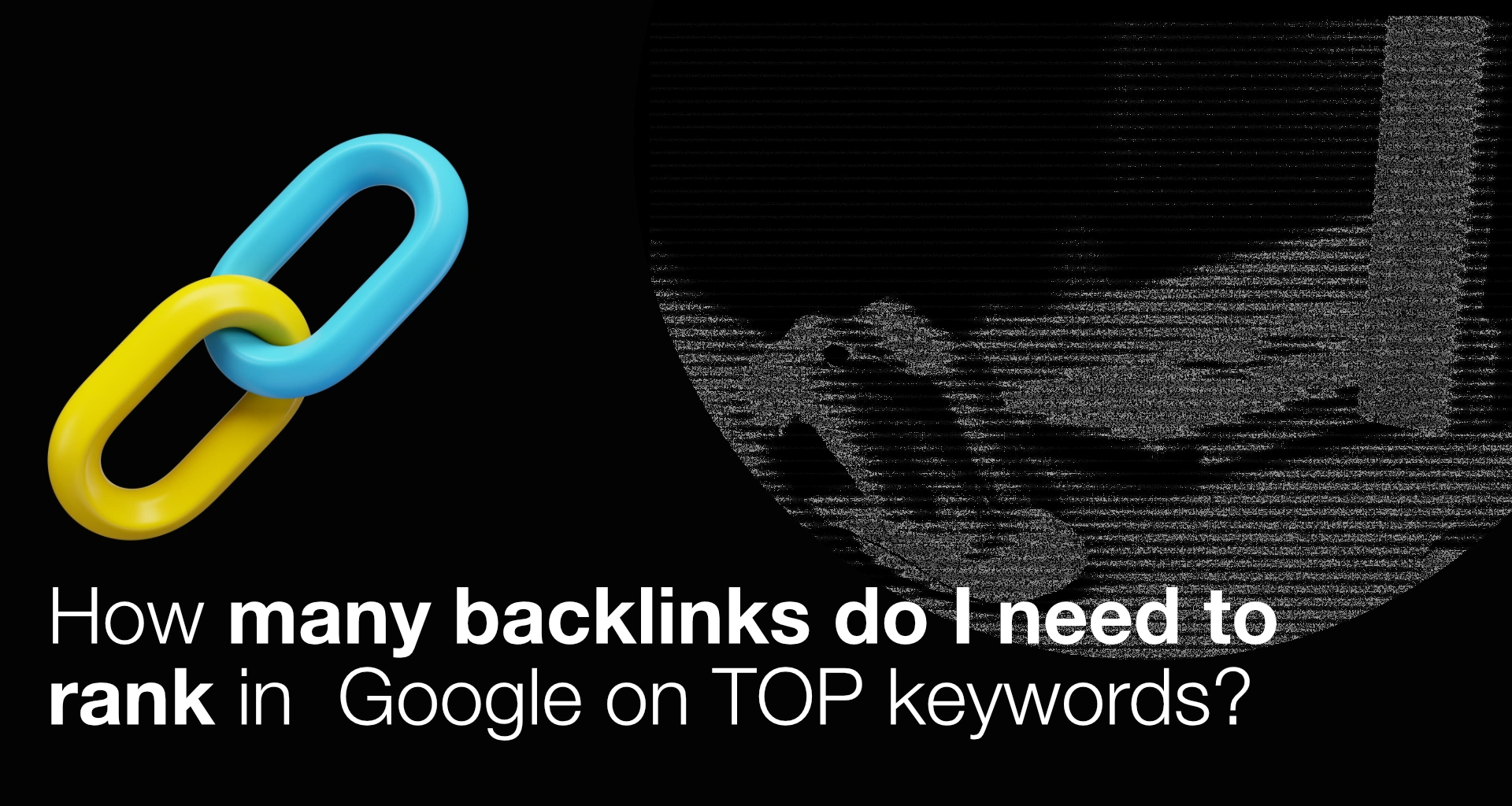How many backlinks do I need to rank my website? - Very common question asked by many professional business owners. Discover the SEO numbers!
Key Takeaways
- How many backlinks you need depends on your competition, target keywords, and industry.
- One high-quality backlink from a trusted, relevant website is worth more than 100 low-quality spam links.
- Avoid sudden spikes in backlink growth as Google may see this as artificial.
- Help website owners fix their broken links by suggesting your content as a replacement.
Are you wondering how many backlinks do I need to get your website ranking higher on Google? You’re not alone! This is one of the most common questions website owners ask, and the answer might surprise you.
In this guide, we’ll explore everything you need to know about backlinks, including modern techniques to check your current backlink profile and practical methods to improve your rankings (post updated: 06/06/2025).
What Are Backlinks and Why Do They Matter?
A backlink is simply a link from another website that points to your website. Think of it like a recommendation from one friend to another. When Website A links to Website B, it’s telling Google that Website B has valuable content worth sharing.
Here’s why backlinks are still important in 2025:
- Trust signals: Search engines view backlinks as votes of confidence
- Authority building: Quality links help establish your website as an expert source
- Traffic generation: People can discover your site through these links
- Search rankings: Backlinks remain one of Google’s top ranking factors
- AI Agents: Yes, Chat GPT or Google AI will count and measure the amount of backlinks your website have.

How Many Backlinks Do I Need To Rank on Page One?
The truth is, there’s no magic number that guarantees top rankings. The question “how many backlinks do I need” depends on several factors:
Your Competition Level
Different industries require different amounts of backlinks. For example:
- A local bakery might need 10-20 quality backlinks to rank well locally
- A national insurance company might need hundreds or thousands
Your Target Keywords
The more competitive your keywords, the more backlinks you’ll typically need. Long-tail keywords (longer, more specific phrases) usually require fewer backlinks than broad, popular terms.
Quality vs Quantity
One high-quality backlink from a trusted website is worth more than 100 low-quality links from spam sites. Google has become much smarter at detecting artificial link schemes – the article from 2024 from Google explains how they tackle low-quality content and backlinks.
How Many Backlinks Should a Website Have?
Instead of focusing on a specific number, think about building a natural backlink profile. Here’s what Google looks for:
Gradual Growth Pattern
Your backlink growth should look natural over time. Avoid these common mistakes:
- Getting 50 backlinks in one week, then none for months
- All your backlinks coming from the same type of website
- Links appearing too quickly after creating new content
Diverse Link Sources
A healthy website typically has backlinks from various sources:
- News websites and magazines
- Industry blogs and forums
- Social media platforms
- Business directories
- Partner websites
- Guest posting opportunities
The Right Ratio
Most successful websites have a mix of:
- 70-80% dofollow links (these pass SEO value)
- 20-30% nofollow links (these still bring traffic and look natural)

Modern Techniques: How to Check How Many Backlinks I Have
Let’s explore both free and paid methods to analyse your current backlink profile, including some clever Google search commands.
Free Method 1: Google Search Console
Google Search Console is completely free and shows you exactly which sites are linking to yours:
- Sign up at search.google.com/search-console
- Verify your website ownership
- Click on “Links” in the left sidebar
- View your “External links” report
This tool shows you:
- Total number of backlinks
- Which pages receive the most links
- Your top linking websites
Free Method 2: Google Search Commands
Here are some clever Google search tricks to find backlinks:
Command 1: Site-specific search Type: site:yourwebsite.com -site:yourwebsite.com This shows pages that mention your site but aren’t on your site.
Command 2: Link search Type: "yourwebsite.com" -site:yourwebsite.com This finds pages that mention your website URL.
Command 3: Brand mention search Type: "your brand name" -site:yourwebsite.com This discovers unlinked brand mentions that you could ask to be turned into links.
You can also use the same techniques to check SEO position in Google.
Free Method 3: Social Media Monitoring
Check these platforms for backlink opportunities:
- Twitter (X): Search for mentions of your brand
- LinkedIn: Look for industry discussions mentioning your content
- Facebook: Monitor relevant groups and pages
- Reddit: Search for your website or brand mentions
Paid Tools for Advanced Analysis
While free tools are helpful, paid tools provide more comprehensive data:
Ahrefs: Shows detailed backlink profiles, including:
- Domain authority of linking sites
- Anchor text used in links
- New and lost backlinks over time
- Feel free to check backlink checker.
SEMrush: Offers competitor backlink analysis:
- Compare your backlink profile to competitors
- Identify gap opportunities
- Track your backlink growth
DIY Link Building Techniques That Actually Work
Now that you know how many backlinks do I need varies by situation, let’s explore practical ways to earn quality backlinks.
The Skyscraper Technique 2.0
This updated version of Brian Dean’s famous technique involves:
- Find popular content in your industry using Google search
- Create something significantly better (more comprehensive, updated, or unique)
- Reach out to websites that linked to the original content
- Politely suggest they consider linking to your improved version
Resource Page Link Building
Many websites have “resources” or “useful links” pages. Here’s how to find them:
Google search commands:
“your keyword” + “helpful resources”
“your keyword” + “useful links”
“your keyword” + “resource page”
Contact these websites and suggest adding your content if it genuinely adds value to their resource list.
Broken Link Building
This technique helps websites while earning you backlinks:
- Find broken links on relevant websites using free tools like Check My Links (Chrome extension)
- Create content that could replace the broken link
- Contact the website owner about the broken link
- Suggest your content as a replacement
HARO (Help a Reporter Out) Method
Journalists constantly need expert sources for their articles:
- Sign up at helpareporter.com
- Respond to relevant queries in your industry
- Provide valuable insights and quotes
- Earn backlinks when your quotes are published

How Many Backlinks Do I Need to Rank: Setting Realistic Expectations
Let’s address the core question – how many backlinks do I need for different scenarios?
New Website (0-6 months old)
- Start with 5-10 high-quality backlinks
- Focus on local directories and industry associations
- Aim for 2-3 new quality backlinks per month
Established Website (6+ months)
- Target 10-50 quality backlinks depending on competition
- Diversify your link sources
- Monitor competitor backlink profiles for benchmarking
Competitive Industries
- May require 100+ quality backlinks
- Focus heavily on domain authority of linking sites
- Consider long-term link building campaigns
Quality Indicators: What Makes a Good Backlink?
A good backlink comes from a high-authority, topically relevant site that shares similar content or audience, signalling trust and context to search engines. Ideally, it uses natural, descriptive anchor text and is placed within editorial content (not in footers or sidebars), ensuring it’s seen by real users and carries genuine referral value.
Additionally, a “dofollow” link from a site with steady traffic and low spam signals will pass more SEO benefit than a link from a low-quality or unrelated domain.
High-Quality Backlink Characteristics
- Relevant websites: Links from sites in your industry or related fields
- High domain authority: Established websites with good reputations
- Natural anchor text: Varies between branded, generic, and keyword-rich text
- Editorial placement: Links within the main content, not sidebars or footers
- dofollow attribute: These pass SEO value to your website
Red Flags to Avoid
- Paid link schemes or link farms
- Websites with excessive outbound links
- Foreign language sites (unless relevant to your audience)
- Automated link building tools
- Links from penalised websites
Measuring Your Backlink Success
Track backlink success by monitoring metrics like referral traffic, domain authority improvements, and keyword rankings over time using tools such as Google Analytics (here is the article explaining why you should use Google Analytics 4 – still relevant) and Moz. Regularly audit your backlink profile to identify high-impact links and disavow any low-quality or toxic backlinks that could harm your SEO.
How many backlinks do I need isn’t just about quantity—it’s about measuring the right metrics:
Key Performance Indicators
- Organic traffic growth: More quality backlinks should lead to increased organic visitors
- Keyword rankings: Track your target keywords’ positions over time
- Domain authority improvement: Use tools like Moz to monitor your site’s authority score
- Referral traffic: Quality backlinks should send relevant visitors to your site
Monthly Monitoring Routine
Set up a monthly review process:
- Check Google Search Console for new backlinks
- Monitor keyword rankings
- Analyse competitor backlink strategies
- Identify new link building opportunities
Common Backlink Mistakes to Avoid
Many website owners make these costly errors when building backlinks:
Mistake 1: Focusing Only on Quantity
Remember, how many backlinks do I need isn’t just about numbers. One quality backlink from a trusted source beats dozens of low-quality links.
Mistake 2: Ignoring Anchor Text Diversity
Using the same anchor text repeatedly looks unnatural to Google. Mix up your anchor text with:
- Branded terms (your company name)
- Generic phrases (“click here”, “read more”)
- Partial match keywords
- Exact match keywords (use sparingly)
Mistake 3: Building Links Too Quickly
Sudden spikes in backlinks can trigger Google penalties. Aim for steady, consistent growth that looks natural.

Advanced Strategies for 2025
AI-Powered Content Creation
Use AI tools to create linkable assets:
- Comprehensive industry reports
- Data-driven infographics
- Interactive tools and calculators
- Updated statistics and research
Video Content Link Building
Video content is increasingly popular for earning backlinks:
- Create educational YouTube videos
- Develop tutorial content
- Share behind-the-scenes content
- Participate in video podcasts
Community Building
Build relationships within your industry:
- Join relevant online communities
- Participate in industry forums
- Attend virtual and in-person networking events
- Collaborate with other content creators
The Future of Backlinks
Quality Will Matter More
Google’s algorithms are becoming better at detecting:
- Natural vs artificial link patterns
- Content quality and relevance
- User engagement signals
- Website trustworthiness
New Link Types
Emerging link opportunities include:
- Podcast mentions and interviews
- Social media stories and posts
- Live streaming platforms
- Virtual event partnerships
Conclusion: Your Backlink Strategy Moving Forward
So, how many backlinks do I need to rank well? The answer depends on your specific situation, but remember these key points:
- Quality always trumps quantity in backlink building
- Start with realistic goals based on your competition
- Use free tools like Google Search Console to monitor progress
- Focus on building genuine relationships and creating valuable content
- Be patient—good backlinks take time to build and show results
The most successful websites don’t just ask “how many backlinks do I need”—they focus on building a diverse, high-quality backlink profile through consistent effort and valuable content creation.
Remember, backlinks are just one piece of the SEO puzzle. Combine your link building efforts with great content, technical SEO, and user experience improvements for the best results.
Whether you’re just starting out or looking to improve your existing backlink profile, use the techniques in this guide to build a stronger, more authoritative website that both users and search engines will love.
